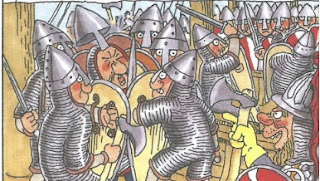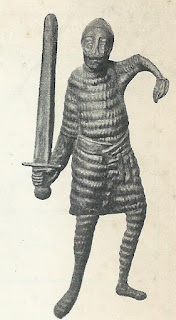 |
| Peter Nicolai Arbo |
5th January 1066, The English king Edward the confessor and then earl Harold Godwinson was proclaimed king at Westminster Abbey the day after the 6th.
Edward the confessor had promised both Harold and William "Bastard" of Normandy the seat of the throne before he died. Both men were distant relatives to the childless Edward the confessor. When William heard of it he quickly raised an army.
Harald Hardrada also claimed the English throne and he was faster than William the bastard and on
8th September,1066 240-300 Viking ships landed on the beaches of Scarborough and began an attempt to gain the English throne.
20th September,1066 Battle of Fulford: Harald Hardrada defeated the English earls Edwin and Walther. 2 days later Harald Hardrada attacked and conquered York.
24th September,1066 Harold Godwinson arrived after marching from London.
25th September,1066 Battle of Stamford bridge
 |
| Battle of Stamford bridge |
Harold Godwindson won, his brother Tostig and Harald Hadrada, was both killed at Stamford Bridge.
Olav Kyrre became the new king after his father Harald Hardrada died. The English army had no time to rest it had to move quickly to South England where the Normans was expected to arrive.
 |
| Duke William of Normandy |
28th September,1066 William the conqueror arrived with 700 ships at Pevensey
A sign from the sky
The Anglo-Saxon Chronicle wrote, that around Easter time, “a portent such as men had never seen was seen in the heavens”. Visible for a week, it was described by some as the “long-haired star”. According to the Bayeux tapestry, this long-haired star meant bad news for poor Harold Godwinson. As his allies looked up at the comet with wonder, the English king was portrayed as being warned by an astrologer, that the comet was an omen of doom. William regarded it as a positive portent.
Battle of Hastings did not take place in Hastings, but it was fought at Senlac Hill 10km north-west of Hastings.
14th October,1066
Daunt by Dawn written by Bard Ai.
A tremor ran through William's camp. Dawn revealed his coat, donned inside-out, a symbol of disquiet on the cusp of battle. His men, already tense, exchanged wary glances. 18 days prior, they had landed on English soil, a formidable 7,500 strong. Now, atop a distant hill, Norman scouts reported the English army, led by Harold Godwinson, awaiting them.
From his vantage point, Harold surveyed the Norman advance in three distinct columns. He ordered his cavalry to dismount, forming a living shield wall against the impending clash. William countered with a hail of arrows before unleashing his infantry. Hampered by the uphill climb, the Normans were repelled, both foot soldiers and cavalry forced to retreat.
The battle raged for hours, but the Normans spotted a chink in the English armor. Thrilled by the chase, English units had pursued retreating Normans down the hill, leaving gaps in their shield wall. William seized this opportunity. He ordered a feigned cavalry charge, luring a large contingent of English after them. With a swift turn, the Normans trapped the isolated English, mercilessly cutting them down.
Capitalizing on their success, the Normans exploited the weakened English lines. Their cavalry sliced through the infantry, panic rippling through the English ranks. "The dead could not fall," wrote Norman Bishop Guy of Amiens, describing the desperate closeness of the English formation. Then, tragedy struck. An arrow pierced Harold's eye, and a Norman knight delivered the final blow. The English army, leaderless and demoralized, crumbled.
William, forever etched in history as "The Conqueror," secured his victory. On Christmas Day, he claimed the English crown, his reign beginning under the glow of a new dawn.The pagan Slavs attacked the leader of the Obrotrites Gotskalk (married to Sweyn Estridsons daughter Sigrid) was killed.
Cruelty and looting followed and church people sacrificed on pagan altars.
A last attack on Hedeby from a combined East Slavic army made the citizens finally abandon the town. The survivors moved across the Schlei inlet and founded the town of Schleswig.
The Saxon lords could not resist the attacks and Hamburg was also burned down.
Sweyn Estridsson made a last attempt to conquer England 3 years later with 240 ships
York was captured and William the conqueror bribed the Danish leader Asbjoern and used the scorched earth tactic "Harrrying of the North".















































